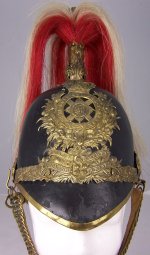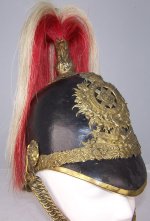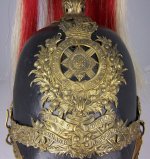RoyalScotsVols
Active member
The county of East Lothian lies to the south of the Firth of Forth in the eastern central lowlands of Scotland. It borders Edinburgh to the west, Midlothian to the south-west and the Scottish Borders to the south. Its administrative centre is the town of Haddington, indeed the county was called 'Haddingtonshire' until 1921.
At the end of the 18th century, the threat of invasion by the French under Napoleon appeared to be very real. The situation seemed critical as the British army was too small and far away but the public responded in an unprecedented movement to take up arms in defence of the land. Many independent units assembled in advance of the Government Act which sanctioned them being formed. One such group was the troop of volunteer cavalry which assembled at Winton Muir in March 1797. Known as the Seton Troop, East Lothian Yeomanry Cavalry, their services were officially acknowledged in May while two further troops from Salton and Gifford were being raised. In the following few years the immediate danger seemed to have receded although the East Lothians had offered their continued service. Accordingly, by the declaration of war in 1803, they were already in the process of raising a fourth troop in Dunbar. That year they were called twice into quarters in Haddington in the expectation of a possible invasion - both false alarms. Had an invasion happened, they were assigned to march south to Newcastle to bolster defences in that area.
Following the end of the Napoleonic Wars the Yeomanry assumed their revised peace-time roles, partly as a local force which could be deployed to support the civil authorities if required. By 1827 the Salton, Seaton and Gifford troops had disappeared although the Dunbar troop continued but, in common with all the Scottish Yeomanry units (except for Ayrshire and Lanarkshire) the unit was disbanded in 1838. However, in response to further French invasion scares, the East Lothian Yeomanry reformed as two troops in 1846 and were joined in 1848 by a Berwickshire troop. This gave rise to the first unofficial title of the ‘East Lothian and Berwickshire Yeomanry Cavalry’. A further troop was added from Midlothian in 1879 and in 1888 they formally became the Lothians and Berwickshire Yeomanry Cavalry being joined by the West Lothian corps in 1892.
Pictured below is a helmet from the final years of the regiment (I’m uncertain if this is an officers or OR’s) comprising a black skull with chin chain attached by rose pattern ear bosses and with an ornate laurel leaf plume holder supporting a white over red horse hair plume. The helmet plate is in the same style as the Royal Midlothian Yeomanry helmet (in a previous thread) showing a four-pointed star with St Andrews cross, overlaid with the intertwined letters ‘VR’, surrounded by the moto ‘Nemo Me Impune Lacessit’ (No-one provokes me with impunity). This is enclosed within a crown topped garter bearing the moto ‘Honi Soit Qui Mal y Pense’ (Shame on he who thinks evil of it). Around the circlet is a wreath of thistles, below which are the four scrolls bearing the name of the regiment.



At the end of the 18th century, the threat of invasion by the French under Napoleon appeared to be very real. The situation seemed critical as the British army was too small and far away but the public responded in an unprecedented movement to take up arms in defence of the land. Many independent units assembled in advance of the Government Act which sanctioned them being formed. One such group was the troop of volunteer cavalry which assembled at Winton Muir in March 1797. Known as the Seton Troop, East Lothian Yeomanry Cavalry, their services were officially acknowledged in May while two further troops from Salton and Gifford were being raised. In the following few years the immediate danger seemed to have receded although the East Lothians had offered their continued service. Accordingly, by the declaration of war in 1803, they were already in the process of raising a fourth troop in Dunbar. That year they were called twice into quarters in Haddington in the expectation of a possible invasion - both false alarms. Had an invasion happened, they were assigned to march south to Newcastle to bolster defences in that area.
Following the end of the Napoleonic Wars the Yeomanry assumed their revised peace-time roles, partly as a local force which could be deployed to support the civil authorities if required. By 1827 the Salton, Seaton and Gifford troops had disappeared although the Dunbar troop continued but, in common with all the Scottish Yeomanry units (except for Ayrshire and Lanarkshire) the unit was disbanded in 1838. However, in response to further French invasion scares, the East Lothian Yeomanry reformed as two troops in 1846 and were joined in 1848 by a Berwickshire troop. This gave rise to the first unofficial title of the ‘East Lothian and Berwickshire Yeomanry Cavalry’. A further troop was added from Midlothian in 1879 and in 1888 they formally became the Lothians and Berwickshire Yeomanry Cavalry being joined by the West Lothian corps in 1892.
Pictured below is a helmet from the final years of the regiment (I’m uncertain if this is an officers or OR’s) comprising a black skull with chin chain attached by rose pattern ear bosses and with an ornate laurel leaf plume holder supporting a white over red horse hair plume. The helmet plate is in the same style as the Royal Midlothian Yeomanry helmet (in a previous thread) showing a four-pointed star with St Andrews cross, overlaid with the intertwined letters ‘VR’, surrounded by the moto ‘Nemo Me Impune Lacessit’ (No-one provokes me with impunity). This is enclosed within a crown topped garter bearing the moto ‘Honi Soit Qui Mal y Pense’ (Shame on he who thinks evil of it). Around the circlet is a wreath of thistles, below which are the four scrolls bearing the name of the regiment.



Last edited:
